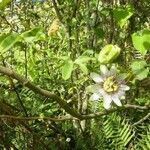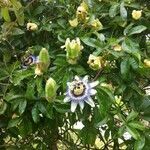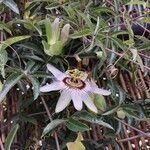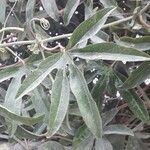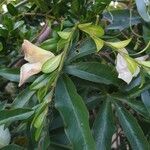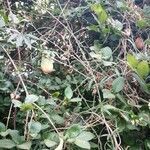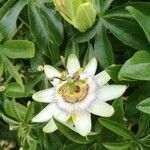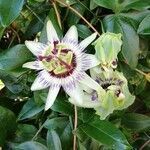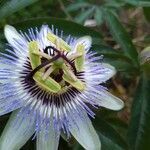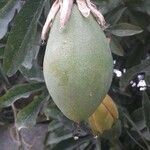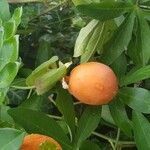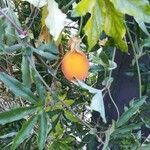Herbaceous vines. Stem terete, slightly angulate, glabrous. Stipules reniform, ca. 1.2 cm, clasping, margin undulate; petiole 2-3 cm, with 2-4(-6) small glands; leaf blade 5-7 × 6-8 cm, papery, base cordate, margin entire, palmately (3-)5(-9)-lobed; lobes ovate-oblong, middle lobe slightly larger than lateral lobes, glabrous. Inflorescence a reduced cyme, central flower not developed, one lateral branch converted to a tendril, flower opposite tendril; bracts broadly ovate, 2-3 cm, margin entire. Pedicel 3-4 cm. Flowers 6-8(-10) cm in diam. Sepals light green outside, white inside, 3-4.5 cm, awn 2-3 mm. Petals white to light green, 2.5-4 cm. Corona in 3 or 4 series, filamentous; outer 2 series (0.6-)1-1.5 cm, base dark purple, middle white, apex bright blue; inner 1 or 2 series 1-2 mm, base light green, apex white and capitate; operculum fimbricate, lobes dark purple, with annular nectary at base; disk 1-2 mm high; androgynophore 8-10 mm tall. Filaments ca. 1 cm, flat, free; anthers oblong, ca. 1.3 cm. Ovary ovoid-globose; styles free, purple, 6-8 mm; stigma reniform. Berry orange-yellow or yellow, ovoid-globose or subglobose, ca. 6 cm. Seeds many, obcordate, ca. 5 mm. Fl. May-Jul.
Glabrous vine. Shoots angular. Lvs 5-lobed almost to base, membranous; petioles 1-3 cm long, with 1-3 stalked glands usually near middle of petiole; stipules c. 2 cm broad, subreniform, undulate, sometimes dentate; lamina lobes subequal; middle lobe 3.5-6.5-(8.5) × 0.5-3 cm, elliptic-obovate or narrow-elliptic, sometimes almost linear on vegetative shoots, membranous and dull above, entire or crenulate, mucronate. Fls ☿, solitary. Pedicels 3.5-6.5 cm long. Bracts 2-2.8 cm long, broad-ovate, entire, cordate, imbricate. Hypanthium inconspicuous. Sepals and petals 3-4.5 cm long, oblong, white inside; sepals greenish outside and with short dorsal horn towards apex; corona threads c. 2 cm long, with base purple, middle white, and apex violet. Stamens greenish; anthers c. 10 mm long, = or slightly > filaments. Ovary glabrous. Fr. c. 3-5 cm diam., subglobose, yellow; pulp scanty and inedible. Seed c. 4 mm long, broad-elliptic, strongly alveolate, silvery brownish.
Stems angular when young, glabrous. Leaves weakly pungent, glabrous; stipules subreniform, 10–20 × 5–10 mm, glandular-serrate; petiole glandular, glands clavate; blade roughly symmetric, 3–10(–16) × 4–11(–14) cm, deeply (3–)5–7(–9)-lobed, middle lobe as long as or longer than lateral lobes, margins entire but often serrate basally on lobes; abaxial fine veins prominently raised, abaxial nectaries scattered along margins. Floral bracts ovate to ovate-oblong, 15–25 × 10–15 mm, margins entire or weakly serrate, eglandular. Flowers: floral tube cuplike, 4–5 mm deep; sepals white, 20–35 × 10–15 mm; petals white, 20–40 × 10–15 mm; corona filament whorls 4, outer filaments dark purple basally, white medially, purple apically (rarely entirely white), linear, terete to slightly flattened, 10–20 mm. Berries yellow-orange to orange, ovoid to ellipsoid, 30–50 × 30–35 mm. 2n = 18.
Perennial climber, 0.9-2.1 m; provided with tendrils. Leaves petiolate, 5-7-lobed; lobes lanceolate, apex acute, margins entire; stipules large, sickle-shaped. Flowers 5-merous; hypanthium saucer-shaped to cylindrical. Sepals free, white to pinkish inside. Petals same as sepals. Corona extra-staminal; filaments of outer corona showy, purple at base, white in middle, blue at tip; inner corona flat or plicate; nectary ring present. Androgynophore distinct. Stamens 5(-8), free. Ovary globose to fusiform; styles 3(4), stigmas capitate. Flowering time Aug.-Mar. Fruit a yellow to orange, ovoid berry, exocarp coriaceous, many-seeded.
A climber which can be 10 m long. It climbs by tendrils. The leaves are divided and finger like. They are dark green. Flowers can be white, pink or blue. They are 8-10 cm wide. The fruit is oval and yellowish orange. They are 4-7 cm long. The fruit are edible.
Climber. Bracts and bracteoles conspicuous, foliaceous, entire. Stipules foliaceous, 10-20 mm long, falcate, remotely dentate. Leaves (3)5(9)-lobed, incisions nearly to base. Flowers white or pinkish; corona purple at base, white at middle, blue at apex.
Leaves (3-)5(-9)-lobed, incisions nearly to the base; fruit ovoid to subglobose, c. 6 cm long.
